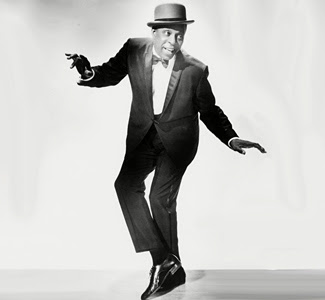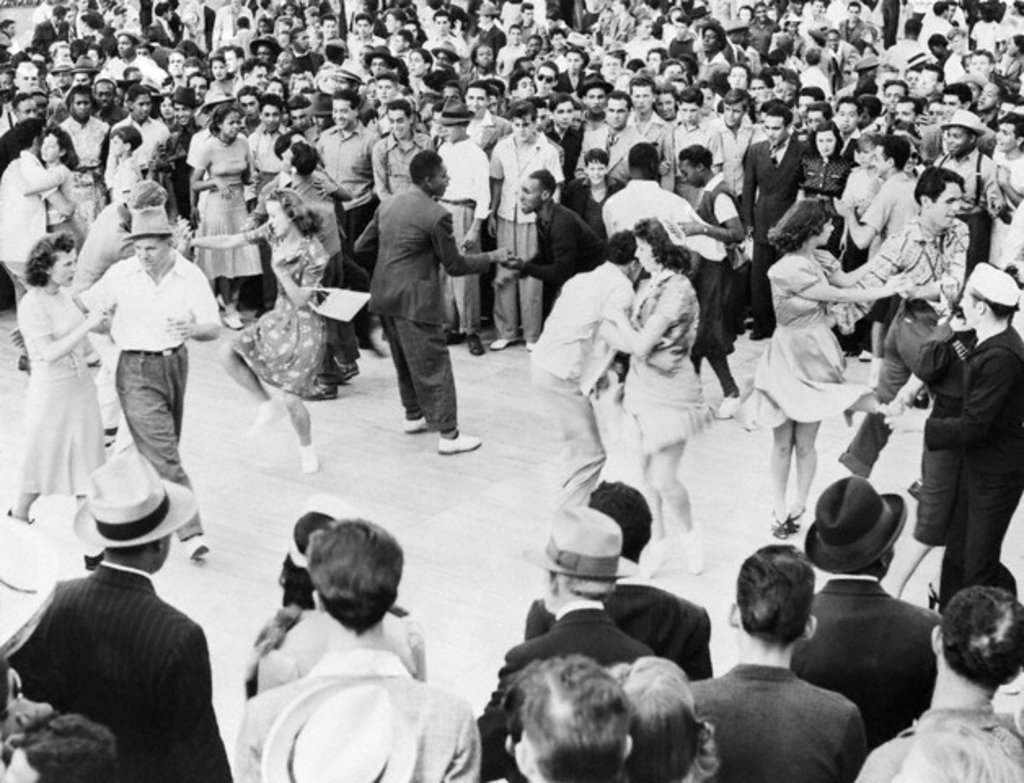We’ve recently taught some John Bubbles style charleston in our classes at the Petersham Bowls Club. Excellent fun.
Category Archives: lindy hop and other dances
Single Ladies, J-setting and battle
This is yet another post about Beyonce’s ‘Single Ladies’
and the Beyond Prejudice performance of Single Ladies routine:
The gender-flex of this routine is more an essential part of the original video than a fan-response to the choreography. The Single Ladies video was choreographed by Frank Gatson and JaQuel Knight and, to quote wikipedia “incorporates J-Setting choreography”.
J-setting (to quote wikipedia again)
…is a highly stylized modern lead and follow style of hip hop dance, characterized by cheerleading style sharp movements to an eight-beat count music. Popular in southern U.S. African American gay clubs, like the vogue-style before it, it became popular by exposure in a pop music video…
Background
In 1970, former majorette Shirley Middleton became troupe leader of the Jackson State University cheerleading group, The Prancing Jaycettes. Middleton wanted something different, and so threw away their batons, and began dancing in formation. Based on a classical cheerleader eight-beat style, the signature thrusts, pumps, and high kicks were developed into a lead-and-follow “wave” through the troupe.[1]
However, the style was strictly reserved for women only until 1997, when male troupe baton twirling member DeMorris Adams, was asked to fill in for an injured female troupe member. After this, although the performing troupe was still female, the crowd supporters started to grow from the colleges gay community.
The wikipedia entry references “The Big Idea: J-Setting Beyond Beyoncé”, Vibe.com (February 2009. Retrieved 2009-11-22) and I think it’s worth adding the clarification from that piece: “The Prancing Jaycettes were the female dance line of the infamous JSU marching band”. Marching bands are important in the history of black vernacular dance in America, and the inherently competitive, battle challenge of marching bands (and cheerleaders and step and… so on) is important here. I do recommend searching for the ‘prancing j-settes’ on youtube for an idea of what was going on.
The Vibe piece adds another great little note:
He was not alone in his adoration of the Prancing J-Settes. “The young men would be on the sideline during practice watching and learning,” recalls Anthony Hardaway, a gay activist and historian from Memphis who was a student at JSU from 1990 to ’94. “My friends would be on the side doing the dance alongside the girls.” However, their imi-tation was not seen by all as flattery. “Teachers and coaches would run the gay boys away,” Hardaway says with a laugh, “because when it was time for the games, the gay boys would be in the stands doing the routine and outperforming the girls on the field.”
There’s something totally excellent about the thought of young, fabulous black boys being shooed away because they might a) engayen the football players (lol in the current Australian AFL climate), and b) outshine the girls. Is there any better battle challenge, any greater call to arms than this?
Here, check this out:
Of course, J-setting has changed since the 1970s, which is the way all vernacular dance works. It responds to trend and fashion to retain relevancy.
Let’s look at JaQuel Knight for a second:
Knight’s muscularity changes the choreography a bit, as do his flat shoes (which change the line of his legs and the movement of his hips). It’s interesting to compare his movements with Dana Foglia beside him. Her hips and legs in high heels give us the more Single Ladies type lines. I’ve written about this before in reference to Balanchine and the Whitey’s Lindy Hoppers, so I won’t go into it again. But this video gives us a fabulous modern day example of the gendering of these types of bodily aesthetics.
But wait, I’m totally off-track. Let’s just look at the essentials of J-setting for a second. This is a call and response type battle/dance. The troupe has a leader who ‘calls’ the steps, which the rest of the troupe then ‘respond’ to by repeating the steps. This is key. The lycra leotards and athletic wear are also key markers of J-setting. Now think about this as something that was happening in gay clubs, and think about gay men’s bodies in these settings. That’s some seriously subversive shit right there. All sorts of complex gendering going on. Sure, those guys are ‘dancing woman’, but they’re also very masculine in their aggressive posturing. But if cheerleading is also clearly about battle and competition, then aggression isn’t as gendered as all that… it’s just played out in gendered terms.
The call and response of j-setting works in slightly different terms in this video with JaQuel Knight, in a teaching context:
In summary, then, J-setting began with marching band dance troupes, and with women dancing. It was taken up by black gay men, partly because of the influence of a male dancer in the troupe, but more probably because the j-setting was totally fabulous, totally competitive, and totally awesome. It retain(s) its competitive element in a gay club context. Here, look at this:
(I included this dodgy quality clip because it gives you an idea of what it’s actually like doing this stuff in real-life settings: the lighting is shit, there are errors (those these guys are tight), it’s not clean and pretty).
J-setting moves out into the wider community, to the point where Beyonce wants to get into that action. Big name j-setting dancers are involved in choreographing the Single Ladies routine.
But wait. There’s more. The Single Ladies routine is referencing a Bob Fosse choreography, which most peeps know as ‘the Mexican breakfast’ dance (there was a fair bit of discussion about this, and this video is kind of interesting for its discussion of Fosse). You can see the Bob Fosse Mexican Breakfast choreography here, but ignore the subtitles.
So, to sum up, Kanye was onto something. The Single Ladies video could be the best video of all time. OF ALL TIME. And J-setting is exciting because it offers a model for competition and battle in dance which isn’t using the standard krumping/hippity hop model. This is really interesting.
My previous posts about this video:
what again?! I’m still crapping on about dance, power, etc
competition dancing
Swinging with Duke
This is a post about Duke Ellington and dance, because he is on my mind at the moment.
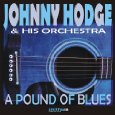 I’ve recently discovered the 1951/52 stuff by the Johnny Hodges band on this dodgy digital download album Pound of Blues is really great for teaching dance, particularly choreography which recognises strict phrasing. It’s good, solid stuff, and I’ve used it for DJing in the past, though not with any particular enthusiasm. The steady, predictable phrasing of songs like ‘Wham’ on this album do not really reflect all of Ellington’s compositions, as anyone who’s tried to choreograph to ‘Rockin in Rhythm’ will know. But Johnny Hodges was, of course, a musician who played with Ellington for a long time. One of the soloists the band leader would compose for, and organise compositions around rather than forcing them to fit into a musician-shaped hole in his band.
I’ve recently discovered the 1951/52 stuff by the Johnny Hodges band on this dodgy digital download album Pound of Blues is really great for teaching dance, particularly choreography which recognises strict phrasing. It’s good, solid stuff, and I’ve used it for DJing in the past, though not with any particular enthusiasm. The steady, predictable phrasing of songs like ‘Wham’ on this album do not really reflect all of Ellington’s compositions, as anyone who’s tried to choreograph to ‘Rockin in Rhythm’ will know. But Johnny Hodges was, of course, a musician who played with Ellington for a long time. One of the soloists the band leader would compose for, and organise compositions around rather than forcing them to fit into a musician-shaped hole in his band.
I’d like to say that this ‘Pound of Blues’ album reminded me of the orsm of Ellington, but that’s not true. Ellington is always on my mind. I love him. I love his music and I own a lot of it. A LOT. I’m a massive fan of the Ellington small group stuff, but I’m also nuts for the bigger bands.
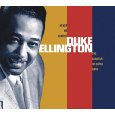 The Never No Lament: the Blanton Webster Band 3CD set was one of the first serious Ellington CDs I ever bought (though it was a lot cheaper then than it is now), and I bought it because dancers and DJs I admire recommended it on the SwingDJs discussion board. It’s great, but as with many of the Ellington recordings I have, the quality isn’t so great. There’s a lot of surface noise (ie scratchy crackly rubbish) and the high pitched stuff sounds awful when I’m DJing. And all that from a CD.
The Never No Lament: the Blanton Webster Band 3CD set was one of the first serious Ellington CDs I ever bought (though it was a lot cheaper then than it is now), and I bought it because dancers and DJs I admire recommended it on the SwingDJs discussion board. It’s great, but as with many of the Ellington recordings I have, the quality isn’t so great. There’s a lot of surface noise (ie scratchy crackly rubbish) and the high pitched stuff sounds awful when I’m DJing. And all that from a CD.
This last point is important, because I recently bought myself another Ellington set, Decca’s Complete Brunswick and Vocalion Recordings 1926-1931. I’d somehow managed to miss this little chunk of Ellingtonia and I needed to rectify the problem. I went with CDs rather than the cheaper downloads because I’m finding download files – especially legit ones – are of such poor quality they make the songs unDJable. The rubbish files plus the scary sound quality of the recordings themselves are just unuseable on shitty sound systems.
I guess I do have kind of an Ellington problem. But then, he’s so interesting, he justifies a little obsessive collecting.
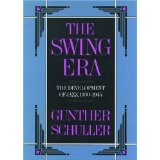 I used to have a long bus commute to uni which I’d spend reading my way through Gunther Schuller’s book The Swing Era: the Development of Jazz 1930-1945 and listening along with my whole Ellington collection on my ipod. I read music (haltingly), and Schuller spends quite a bit of his time examining scores in detail. I’m not entirely convinced by everything Schuller says, but Schuller’s is an interestingly scholarly approach to a musician who was as comfortable with concert halls as dance floors.
I used to have a long bus commute to uni which I’d spend reading my way through Gunther Schuller’s book The Swing Era: the Development of Jazz 1930-1945 and listening along with my whole Ellington collection on my ipod. I read music (haltingly), and Schuller spends quite a bit of his time examining scores in detail. I’m not entirely convinced by everything Schuller says, but Schuller’s is an interestingly scholarly approach to a musician who was as comfortable with concert halls as dance floors.
Today’s dancers are familiar with many of the soundies and film fragments featuring Ellington’s band. Mostly because they also featured dancers. The most famous of these is probably Hot Chocolate (Cottontail), with Whitey’s Lindy Hoppers:
My favourite is Bessie Dudley and Florence Hill dancing to Ellington’s band playing ‘Bugle Call Rag’ in the 1933 film Bundle of Blues:
Bessie Dudley was married to Snake Hips Tucker, and she appeared with him in Ellington’s 1935 film Symphony in Black. There’s a scene in that short film where Tucker’s character throws Billie Holiday to the ground, and you can’t help but think of the verisimilitude – Tucker was a brutal, violent man who abused Dudley.
Ellington’s relationship with dancers was strong and complex. He worked extensively with dancers at the Cotton Club and on film, and travelled with Dudley and other dancers on tours. And later, as his music became more complicated and challenging, his productions with dancers and choreographers like Alvin Ailey also became more challenging.
There’s an interesting article by Patricia Willard called ‘Dance: the unsung element of Ellingtonia’ (Australians can read the full text version here, but there are other versions available online if you google). In that article Willard writes
Duke thought and spoke in dance vernacular. Maneuvering a remarkably stable roster of assertive, quirky, occasionally aggressive individualists into a consistently identifiable and cohesive big band through the decades demanded an accomplished psychologist and master manipulator, which he was. He proudly referred to his role as “The Choreographer.” (Willard)
This idea of Ellington’s music as dance music (which Willard pursues in that article) is nice. Ellington himself said “Swing is not a kind of music. It is that part of rhythm that causes a bouncing, buoyant, terpsichorean urge.” (Ellington, quoted by Willard) This idea that Ellington was at once engaged in popular culture and able to move on to all that difficult artier music and concert dance is just one bit of proof of his versatility.
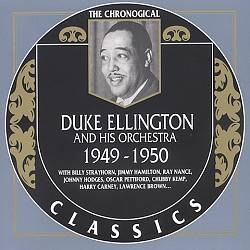 Most of my love for Ellington is centred on his earlier stuff and on those small group recordings. My interest tends to wane at about 1950, to be honest, but that’s not a strict rule. There’s a song called ‘B Sharp Boston’ which Ellington recorded in 1949 and which used to get around on those dodgy ripped compilation CDs as ‘Sharp B Boston’. I picked up the Chronological Classics Duke Ellington Orchestra 1949-1950 CD in about 2006, and discovered it was actually called ‘B Sharp Boston’, and that there was a bunch of other great stuff on that CD that makes for top DJing (I’ve written about this before in Duke Ellingon’s Difficult 1949-1950 period). ‘Joog Joog’, for example, is one of my favourites (I like to pair it with Doris Day singing ‘Celery Stalks At Midnight’). A fair chunk of stuff on this CD is, however, already edging over into dissonance and confusing timing which makes for challenging dancing.
Most of my love for Ellington is centred on his earlier stuff and on those small group recordings. My interest tends to wane at about 1950, to be honest, but that’s not a strict rule. There’s a song called ‘B Sharp Boston’ which Ellington recorded in 1949 and which used to get around on those dodgy ripped compilation CDs as ‘Sharp B Boston’. I picked up the Chronological Classics Duke Ellington Orchestra 1949-1950 CD in about 2006, and discovered it was actually called ‘B Sharp Boston’, and that there was a bunch of other great stuff on that CD that makes for top DJing (I’ve written about this before in Duke Ellingon’s Difficult 1949-1950 period). ‘Joog Joog’, for example, is one of my favourites (I like to pair it with Doris Day singing ‘Celery Stalks At Midnight’). A fair chunk of stuff on this CD is, however, already edging over into dissonance and confusing timing which makes for challenging dancing.
These sorts of awkward combinations of note and timing really heralds bop. But years ahead of other peeps. Listening to even Ellington’s 30s stuff, you hear a hint of the dissonance that was to come. I tweeted the other day “It’s like Ellington heard collective improvisation in NOla jazz and went “hm. Dissonance.” In 1938.” And @twobarbreak replied “Look where all of Ellington’s players were from, and who they learned from. your hunches closer to right on than you think!”
Again, though, it’s fascinating that Ellington could produce excellently danceable songs like ‘B Sharp Boston’ and ‘Joog Joog’ at the same time as he was really getting into much more experimental stuff. By the end of the 40s Ellington had well and truly begun to explore crazy arse stuff that doesn’t always work for dancing. Well, unless you’re Ramona and Todd at ILHC this year
I read an interesting blog post recently (cannot remember where, I’m sorry – PLEASE let me know if you know the one I mean), where someone cleverly pointed out a couple of recent lindy hop choreographies that worked with this sort of ‘difficult jazz’. One of them was Giselle Anguizola and Nathan Bugh’s 2011 Classic Lindy entry in ILHC:
I keep an eye on Giselle, because she’s been involved in some interesting projects over the years, from Girl Jam to working with jazz bands on the streets of New Orleans. Both are interesting, not just as exercises in jazz dance and jazz dance skills, but in the enculturation of dancers in jazz tradition.
One of the things I really like about the way dancers like Giselle and Chance engage with bands on New Orleans streets is their recognition of turn taking. Soloists in a band take turns, even (especially) the vocalists. In these street jazz groups, the dancers function as soloists, taking their turn, and then stepping back to let the musicians shine. They’re not only responding to the music they hear, but also functioning as part of the band, and part of the performance. Most modern lindy hoppers barely manage to look up and see the band they’re dancing ‘to’, let alone take a moment out to admire what they hear.
And of course, all this talk of New Orleans jazz, solos and recognising individual talent within a collective ensemble takes us back to that idea of Ellington’s most radical work being a response to the interests of the musicians in his band, many of whom were from New Orleans or taught by New Orleans musicians. The most radical ‘art’ part of Ellington was perhaps his references to tradition and vernacular, everyday culture?
Other things about Ellington and dance I couldn’t fit in this piece of writing:
- My new favourite ILHC 2012 clip, Melanie and Joshua in the Lindy Hop Classic category dancing to Ellington’s 1941 version of ‘Jumpin’ Punkin’s’:
-
The Lincoln Centre Jazz Orchestra’s album Live in Swing City: Swinging with Duke.
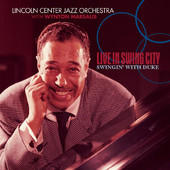
Probably the most overplayed, most popular, excellent modern big band swing album. Recorded live with a crowd of dancers, this album features the most accessible of Ellington’s work, and is an excellent gateway drug for new dancers interested in discovering swing music. - Todd Yannacone again, this time with Naomi Uyama dancing to Ellington’s ‘Main Stem’ in about 2006:
References:
Willard, Patricia, ‘Dance: the Unsung Element of Ellingtonia” The Antioch Review, 57.3 (Summer 1999): p 402
Schuller, Gunther, The Swing Era: The Development of Jazz, 1930-1945, Oxford University Press: USA, 1989.
To pwn or be pwnd
(linky)
So, should I go in this solo jazz comp at the end of the month? I have zero chance of winning, but there will be many chances to show off. I’m of two minds, though. The primary discouragements are:
- the cost of entry
- the long, tedious night of competition for one small block of showing off
- looking like an idiot in front of people from my town and from other towns (the latter is most worrying – there are lots of peeps coming from interstate)
- getting really stressed about it before the weekend
Primary encouragements:
- chance to show off
- a focus for my dancing – something to structure my own preparation besides teaching
- promotion for my classes (this is a big one, but it could go terribly wrong if I go terribly wrong)
- just something to do at a night I might not otherwise attend because #boring
- getting over a fear of looking like an idiot and embarrassing myself
I’ve done this before, but I’m not a massive fan of solo comps that are just high tempos. I’ve found that most of the dancing in the solo comps I see up here ends up being a bunch of tricks with no reference to the music. And the jam battle at the Speakeasy the other week was so inspiring and exciting with its lower tempos (all sorts of people went in it and did good work) I don’t want to tarnish the memory.
I like mixed tempos in a solo comp because we rarely see people solo dancing at more moderate tempos where they’re forced to do good quality movement and can’t hide their fuck ups. And I have a better chance at slower tempos because I am, frankly, not 20 any more and my nearly-forty body can’t quite hack the higher tempos, and more importantly, the aftermath of preparing and competing for this sort of comp. Yeah, nanna got issues. Weep, wail and gnash the teeth.
What’s all this got to do with that version of Stomping At The Savoy up there? Well, that’s my favourite shim sham song, and I’m currently in renewed love with the Al and Leon shim sham. It’s my favourite routine at the moment because it’s both chillaxed and complex. The Big Apple is high energy, crazy complex and super fun. The Al and Leon shim sham, though, does some interesting steps, but really relies on the dancers being able to make chillaxed look good. It’s much easier to pwn with a super fast high energy song than with a slower, chillaxed song, and I like the way Al and Leon maintain chillax at all tempos, and still bring some really challenging shapes and rhythms.
Ah look, I think I’ve just convinced myself. Perhaps I should add some sort of lindy hop comp to the night so I can get my money’s worth?
Jazz dance and jazz music
Ok, so most people reading this will know that I’m now teaching lindy hop and solo jazz once a week (and have been since February). We teach one beginner lindy hop/partner dance class, and one solo dance class each week. The solo class cycles through historic routines, drop in sampler classes and material we’ve choreographed ourselves.
Our approach tends to be driven by technique, historical accuracy, understanding music and dancers developing their own personal style. That means that we don’t rush through choreography, we take a lot of time to teach each step and make sure people are doing things safely and properly. We also encourage dancers to experiment with steps in their own way (rather than getting them ‘right’), and we emphasise the fact that ‘looking cool’ or ‘looking sexy’ isn’t the goal with most eccentric jazz steps. Sometimes you want to look really weird or unusual or intimidating. I’ve found this quite exciting, as we teach a lot of women students, and for women students to be exploring ‘looking weird’ with enthusiasm… well, it warms the cockles of this cranky feminist’s heart. Also, their wackiness makes her lol. Double win.
I haven’t taught dance in YEARS (since about 2002 or so), so there’s been a steep learning curve as I figure out how all these things work. Though I have stacks of uni teaching experience, and I did have that dance teaching experience, plus about fourteen years of lindy hop under my belt, teaching dance isn’t like teaching uni, and the way we used to teach in 2002 is so yesterday’s news. Now we talk about posture and weight changes and rhythm ffs. And dancing to teach isn’t like social dancing or competitions or performances – you have to be very clear in your movements, be cognisant of what you’re actually doing with your body, and then – most importantly – be able to articulate what you’re doing in very few words.
INORITE. It’s HARD!
I would have been writing lots of posts about this stuff, but my brain has been busy with other things this year (hence the relative quiet round these parts… well, the lack of substantive posts anyway), and because I teach with a partner, I don’t really feel I can blabble about our class preparation, politics and preparation on the internet. But mostly I haven’t been writing about it because I just haven’t been able to get my brain together. Though I have had lots of ideas and things to say!
But here’s something I’ve just found on my laptop which I wrote on the coach to Canberrang last month. I’ve written a few things on those three-four hour coach trips to our nearest lindy hopping neighbour, but this one had been forgotten. Reading it now, it seems extra relevant to the way I think about dance and music. The square bracketed bits are things I’m adding now.
Here it is:
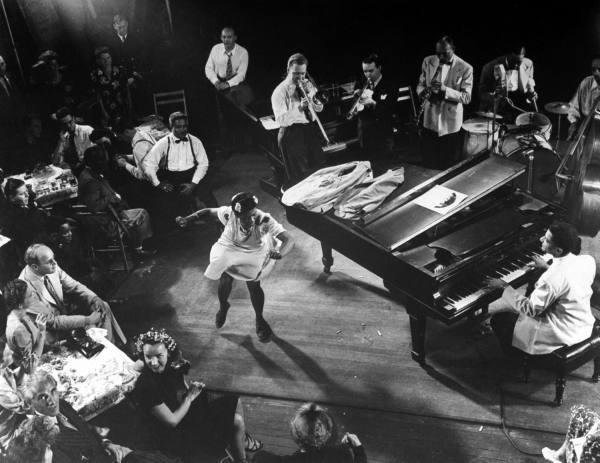
(“Pearl Primus performing to “Honeysuckle Rose” played by Teddy Wilson at piano, Lou McGarity on trombone, Bobby Hackett on trumpet, Sidney Catlett on drums & John Simons on bass during jam session at Gjon Mili’s studio” – Gjon Mili – New York – 1943 linky)
One thing I’ve noticed about all this work on solo jazz [that I do for teaching] is that my sense of musicality has changed. When I want to add some sense of music, I now move to my feet. I want to step out a rhythm or the timing with my feet, rather than wiggling my body.
I’ve also found a new pleasure and interest in the way jazz steps embody (or articulate?) specific rhythms. So a kick ball change [KBC] is a particular syncopated rhythm, a little different to a triple-step. And a fall off the log [FOTL] can be in plain time, or syncopated. And I like the way a boogie back can be syncopated with a kick ball change at the beginning, or a simpler step step step rhythm.
[I’ve also noticed that these steps are the basic vocabulary of jazz dance. You really need to know how to KBC and FOTL and so on before you can really learn good, complex historical choreography. The old school guys built things from the rhythm up, whereas today choreography seems to start with the bigger shapes. I had thought that the ‘steps’ (eg ‘the shorty george’ or ‘the scarecrow’) were the building blocks, but they’re not, really. The rhythms are the most important part, added to structures like ‘the shorty george’ or ‘the boogie back’. The rhythms are the thing.]
Congruently (or inevitably), this has led me to a renewed interest in some of my favourite musicians, particularly the ones who make complex use of timing. I like Bennie Goodman’s small groups for their sharp, precise timing and organisation, and I like a smaller group for the way each instrument plays a clear, specific role in the rhythm. I’m liking larger bands as well, but more for the way they layer up rhythms and melodies.
For me, all this interest is rhythm is the product of getting a handle on the shift from waggling my hands or arms or upper body to be musical, to moving my actual weight. Which of course means that my dancing is now rhythmic in a very different way. My weight changes – my actual dancing – is now musical and rhythmical in a fundamental way, rather than in a decorative or surface way. I’ve found all this bloody hard to get my brain and body around. It’s a lot easier to just waggle your arms about in the air. But learning to change weight in a particular rhythm, and to combine weight changes with staying on the same foot, but jumping up and down, is really hard.
I think it’s made my dancing a lot stronger. Teaching has helped me understand that good ‘styling’ isn’t something you add on like icing to a cake. Fundamentally sound technique is its own styling. Movement which begins in your core, and with changes in weight, has consequences on the rest of your body. I have begun to feel that what happens in your arms, for example, should be a consequence of what’s happening lower down in your body. So twirling your hands about in the air should be a direct result of movement beginning in your core or in your feet, rather than icing you slap onto your cake base.
But as I write that, I can’t help but think about people like Al Minns, who would ice technically sound movement with twirly whirly type hand movements. I guess the difference is that he was doing the twirly whirlies and good body stuff. Whereas a lot of modern dancers focus on the twirly whirlies rather than on sound core and weight changes.
[The trickle down effect of all this for me, has been to change my lindy hop. I’d’ thought that more solo dance work would mean that my lindy hop would get busier as I shoved more of these fun steps in. But that’s not been the case. I’m also doing a lot more concentrated leading these days, as I’m teaching as a lead and needing to keep those skills sharp. And because I’m finding our class content so interesting, I’m leading far more on the social dance floor as well.
So by the time I get to following in lindy hop, I’m finding that I’m quite happy to just blank out and follow. I know. It blows my mind too. But all that solo work, all that rhythm-from-the-ground-up stuff (as well as my new passion – pilates) means that ‘just following’ is now a very different creature. The basic triple steps of a swingout – they can be truly wonderful, magical things if you make them the very best rhythms-from-the-ground-up. And all that control and awareness of how my own body works that I’ve developed through solo dance and choreographing for classes (and breaking down other people’s choreography) has meant that my basic following is much more under control and at the same time a lot more relaxed.
I’d never have expected all this when I got so seriously into solo dance. But it’s such a nice surprise.]
Dean and Bing
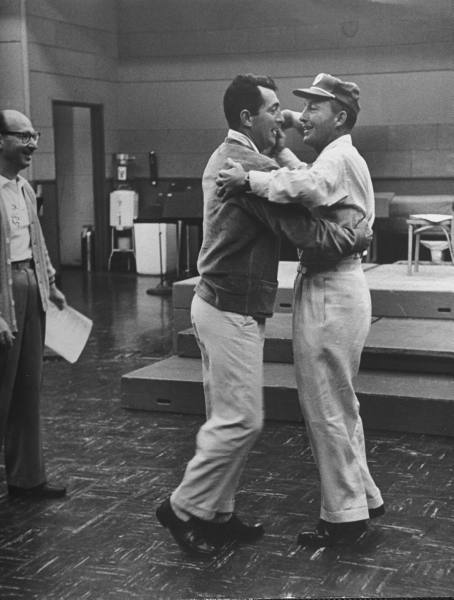
Dean Martin and Bing Crosby, 1958, photographed by Alan Grant from Life Magazine
No news
[rage edit]HEY, if you’d like to give me a serve about being some sort of elitist, how’s about you a) read some of this blog, b) read my comment below. Because I am onto your shit, and I will NOT tolerate it. While I’m at it I DO HAVE A CLUE ABOUT THE RELATIONSHIPS BETWEEN ETHNICITY, CLASS AND CULTURAL CAPITAL IN LINDY HOP, YOU IDIOTS.[/]
I’d write a post about gender and DJing, but nothing has changed since the last time I wrote about it. Women do most of the local DJing, men dominate the DJ line ups at big events. Women DJs problem solve collaboratively, male DJs don’t. Men mansplain technical problems to me when I’m DJing (even if they know nothing about sound gear). There are one or two exceptions.
I’d write a post about labour and pay in the lindy hop world, but nothing has changed since the last time I wrote about it. Teachers, DJs and volunteers are overworked, underpaid and exploited. Dancers refuse to pay more than $40 for a big live band playing for four hours, even though they’re getting the best goddamn dancing of their lives in a restored ball room with the best musicians in the country. Fuckers still make volunteers work for hours and hours, and DJs still aren’t being paid properly by large events (if at all). No, comping entry is NOT THE SAME AS PAYING.
LINDY HOPPERS: stop being such bloody tight arses. Pay more money for live music. Pay more for events run by dancers, just so you can dance. $6 for a DJed gig? IT IS NOT ENOUGH. $20 for a live band in a large, clean space with a good dance floor? INSUFFICIENT. Refusing to pay more than $10 for a four or five hour late night party featuring two rooms of music, six DJs, free food and requiring about 25 people’s worth of labour? YOU ARE TOO TIGHT, DANCERS.
Just in case you thought things were totally fucked, they’re not. This past weekend I counted three or four women who only lead, who I had not seen out social dancing before. They were all wearing nice waistcoats and trousers and jackets and ties and were PWNING ALL. Male leads: you need to level up, because the sisters PWN YOU; your half-arsed leading, your lack of triple steps, your bullshit lazy arse lack of bounce is being shown up. It’s not too late: GO TO CLASS. LEARN ALL THE THINGS. GET GOOD. Male follows: GET ON THE GODDAMN FLOOR.
WimminDandyfiles
My enthusiastic approach to solo dance has led to the explosion of two waistcoats. Need a) smaller boobs or b) stretch fabric. #ICHOOSEB
Whitey’s lindy hoppers
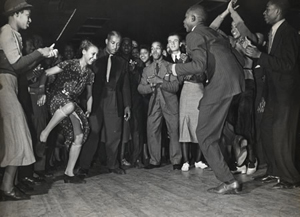
Herbert ‘Whitey’ White at the Savoy with some Whitey’s Lindy Hoppers. Ann Johnson on the left, Long Legged George Grenidge opposite her, Al Minns to the right.
I can’t remember where I found this photo online (it’s just been sitting in my pictures folder waiting for an opportunity to shine), but I got the info about the dancers from Savoy Style, a very useful website.

